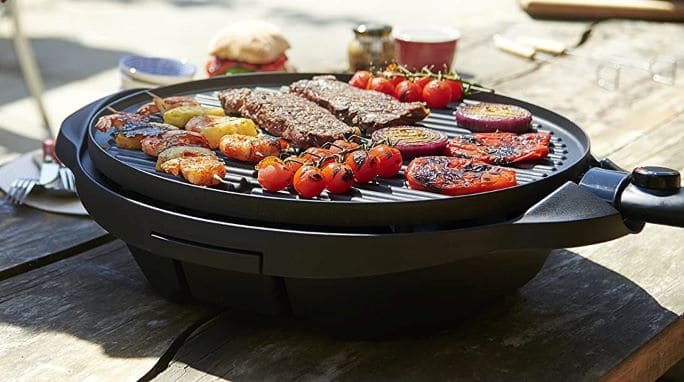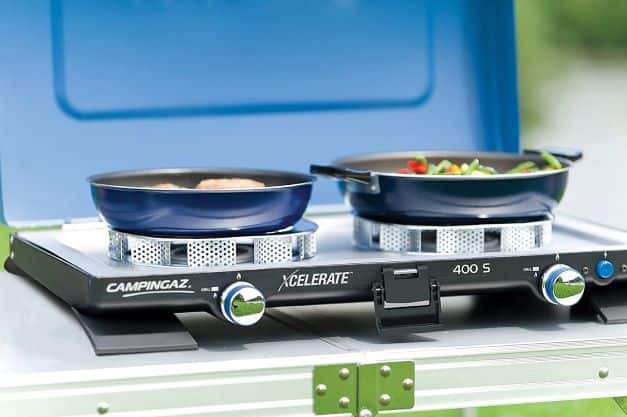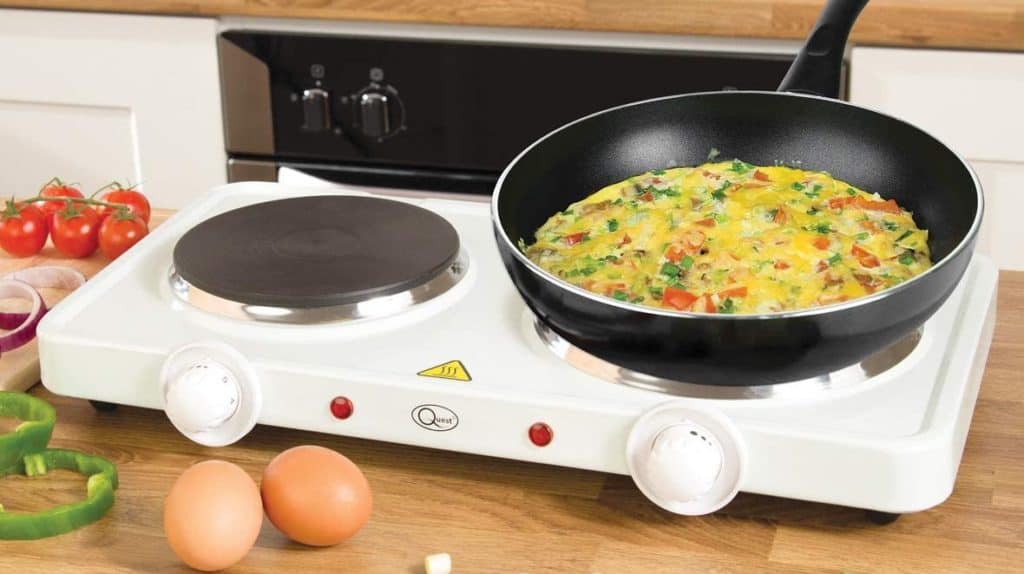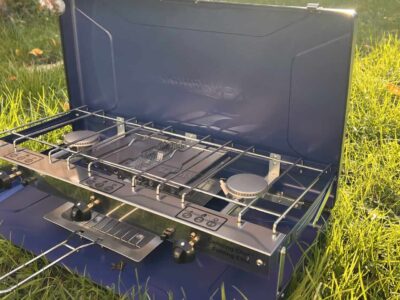This post contains affiliate links.
When I first started camping, I did not consider the type of stove to buy. I purchased the cheapest I could find. It was not until after our first camping trip that I realised my stove was unsuitable for more than two people.
There are so many camping stoves; what will be best for you can be confusing. It’s only because of the experience of many camping trips that I learnt how stoves could frustrate you or make life easier.
Making the right choice: Factors to keep in mind when buying a camping stove for the family
Avoid the mistake I made by impulsively buying the first stove you come across. It’s crucial to consider the amount of cooking you’ll be doing, especially when dealing with hungry kids and the need to juggle multiple items on a portable stove.
Several key factors should guide your decision-making process:
- Size, weight and compactness – Evaluate the stove’s dimensions and weight to ensure it fits well within your setup and is easy to transport.
- Type of cooking – Consider the level of cooking you’ll be comfortable with and the specific meals you plan to prepare.
- Electrical or gas – Determine whether you prefer electric or gas stoves based on your cooking style and available resources.
- Tabletop or free-standing – Consider whether a tabletop or free-standing stove suits your requirements and the available space in your camping area.
- How many people are in a group – Assess the number of people in your group to determine the stove’s capacity and cooking surface area.
- Do you want instant heat? – Decide if you prefer a stove that offers quick and immediate heat for efficient cooking.
- Will you use a BBQ alongside a stove – Consider whether you will be using a BBQ alongside the stove and ensure compatibility between the two.
- Budget – Establish a budget range and explore stoves that fit within your financial limitations.
- Weather conditions – Consider the weather conditions you will likely encounter and select a stove that performs well in those environments.
- Will you have additional shelter for cooking – Determine if you will have additional shelter or protection for cooking, especially during adverse weather conditions.
- How many Amps will you need – Assess the number of amps needed to operate the stove efficiently and ensure compatibility with your power source.
Be careful considering these factors. These will help you make an informed decision and select a stove that meets your cooking needs and enhances your camping experience allowing you to enjoy your outdoor adventures.
Gas or electric camping stove: Choosing the right option for your outdoor cooking needs

Regarding camping stoves, personal preferences vary between gas and electric options. Consider whether you will always have access to an electrical hookup (EHU) during your camping trips. This will help determine the type of stove best suits your needs.
- Camping stove options – Consider having two camping stoves to provide versatility and flexibility in meal preparation. A double gas burner and a multicooker can offer the convenience of two different cooking fuel options, ensuring quick and easy meal preparations for various camping scenarios.
- EHU availability – With the surge in Staycation holidays and the challenges of securing a pitch with EHU, evaluating your access to electrical supply is crucial. If you frequently camp without access to electricity, investing in an electric stove may not be practical. Another consideration is the cost of an EHU pitch. Prices have doubled within the past year. To help save money, I have opted for a solar generator, which has saved money on pitch prices, and it complies with a campsite generator policy as it is not fuel powered. I have a Jackery, which is suitable for all our needs when camping and environmentally friendly, and there is no harm to wild animals or disturbing other campers. Read more about solar generators and find out how they work.
- Cooking efficiency and safety – Gas stoves are ideal for breakfasts, especially with a double gas burner and a grill for toasting. However, consider the safety restrictions, as pans should not overhang the hob, limiting the use of pans brought from home.
- Multicooker for versatility – A electrical multicooker is a valuable addition to your camping equipment, allowing you to cook entire meals in a single pan. Making it convenient for larger groups and reducing the pressure of meal preparation. Another positive of a multicooker is converting it into an oven using foil. This gives you the flexibility to cook chips and pizza, which is ideal if you have youngsters.
- Managing gas usage – When using a gas stove, estimating how long your gas supply will last is crucial. Understanding the average burn rate of gas (2.5g per minute and 150g per hour) can help you plan and ensure you don’t run out of gas during your camping trip. Depending on the type of stove you buy will determine how long the gas will last. Gas will seem to burn faster if windy, as you will have it higher to compensate for inconsistent heat. Before buying a camping stove, read our article on how long the different types of gas canisters will last, as this will help you to decide on the type of camping stove.
- Stress-free cooking experience – The stress of cooking can significantly impact your camping holiday. Unpredictable weather conditions and difficulty keeping a gas stove alight in windy situations can lead to frustration. Switching to an electric stove can be a lifesaver, providing a reliable cooking alternative. When using a gas stove, you will need a windshield, this will help to protect your gas supply. You can buy a small windshield with about 6 sections, although they can be fiddly to stand, especially on a table. A 3 fold windshield from Amazon is ideal for a single portable gas stove. The stove fits comfortably inside and is protected from the wind.
Having the choice of two different types of cooking fuels reduces the pressure of preparing meals, as both are quick and easy.
Choosing a family camping stove: Gas or electric? Exploring the pros and cons
When selecting a family camping stove, choosing between gas and electric boils down to personal preferences, specific camping needs, and the desired cooking experience. Consider factors such as performance, fuel availability, convenience, safety, cooking flexibility, and features. By weighing the pros and cons of both options, you can choose a camping stove that suits your family’s outdoor cooking requirements.
Performance and efficiency
| Gas camping stove |
|---|
| Rapid heat and precise temperature control – Gas stoves offer quick heating times and precise temperature adjustments, allowing for efficient cooking. |
| Reliable in carious conditions – Gas stoves perform well in different weather conditions, including wind and cold temperatures, ensuring consistent performance. |
| Electric camping stove |
|---|
| Consistent heat 0utput – Electric stoves provide a steady heat output, allowing even cooking without hotspots. |
| Easy operation – Electric stoves typically have user-friendly controls, making them straightforward, especially for novice campers. |
Availability of fuel and convenience
| Gas camping stove |
|---|
| Widely available fuel – Gas canisters are readily available in camping stores and outdoor retailers, making it convenient to find fuel during your trips. |
| Portability and flexibility – Gas stoves are generally compact and lightweight, allowing easy transportation and setup at different campsites. |
| Electric camping stove |
|---|
| No need for fuel refills – Electric stoves eliminate the need to carry and replace gas canisters, reducing the hassle of refuelling. |
| Compatibility with power sources – Electric stoves can be used with various power sources, such as campsite hook-ups or portable generators, providing versatility. |
Safety considerations
| Gas camping stove |
|---|
| Fire risk – Gas stoves involve open flames, which require careful handling and monitoring to prevent accidents. |
| Ventilation requirements – Adequate ventilation is necessary when using a gas stove to ensure proper combustion and prevent carbon monoxide buildup. |
| Electric camping stove |
|---|
| Lower fire risk – Electric stoves eliminate the open flame element, reducing the risk of fire-related incidents. |
| Electrical safety – Attention should be given to using the stove with a reliable power source and following proper electrical safety guidelines. |
Cooking flexibility and features
| Gas camping stove |
|---|
| Versatile cooking options – Gas stoves often come with multiple burners, enabling the simultaneous cooking of various dishes. |
| Grill and griddle compatibility – Some gas stoves offer grill or griddle attachments, expanding cooking possibilities. |
| Electric campings stove |
|---|
| Even heat distribution – Electric stoves typically provide consistent heat across the cooking surface, ensuring uniform cooking results. |
| Additional features – Some electric stoves may offer built-in timers, temperature presets, or adjustable heat levels for enhanced cooking convenience. |
Gas camping stoves: Portable and efficient cooking solutions

Gas camping stoves offer portable, efficient, and reliable cooking solutions for outdoor enthusiasts. Whether you opt for a single or double stove, these versatile cooking devices provide instant heat and convenience. You can enjoy delicious meals during your camping adventures with proper safety precautions, suitable gas regulators, and the right fuel choices.
- Single gas camping stoves – Single portable gas stoves are compact, lightweight, and usually come in hardshell plastic. They use butane gas canisters securely stored in a lockable enclosed section on the side. These stoves are easy to operate with a simple ignition and gas control dial. A gas canister lasts approximately 3 hours, depending on usage and conditions. Prices range from £19.99 to £70, with a recommended price range of up to £24.99 for a single portable gas stove.
- Double gas camping stoves – Double gas camping stoves make meal preparation easier, providing two burners for simultaneous cooking. These stoves can operate as single stoves, featuring dials for gas control and automatic ignition. However, they require a hose connection to a gas bottle (butane or propane) via a hose. Gas is stored at high pressure, necessitating the usage of a suitable regulator to ensure correct gas flow. Popular brands like Campingaz and Calor Gas offer refillable cylinders, providing cost-effective options.
- Windshield and safety precautions – We recommend using a windshield with your gas camping stove to optimise performance. Windshields can be purchased separately or included in a kitchen unit. While gas stoves generate instant heat, it’s important to position them away from tents and in well-ventilated open areas for safety.
- Choosing the right gas and cylinder – Campingaz and Calor gas are the leading brands for camping stove fuel. It’s important to note that Campingaz stoves require their specific cylinders, while Calor gas bottles are unsuitable for Campingaz stoves. Gas cylinders can be purchased as new or refills, with subsequent refills costing around 50% of the price of a new cylinder. Initial costs for a new cylinder range from £70 to £100, depending on the size. Refer to our article on how long gas will last, boil time and best prices for buying your gas.
- Safety features – Gas stoves have safety features. For gas stoves that require a hose and regulator, control the flow pressure of the gas. At the same time, the single portable gas stove has a clip that secures the gas canister in place to avoid gas leakage.
- Recommended gas stove options – Refer to our article for a comprehensive list of recommended double and single gas camping stoves. We provide details on power, gas type, and estimated gas consumption during your trip. Our thorough testing and research will help you make an informed purchasing decision, including the best places to buy these stoves based on price and overall value.
Electric camping stoves: Guide for efficient outdoor cooking

Electric camping stoves offer a practical cooking solution for campers seeking convenience and ease of use. By understanding wattage limitations, safety precautions and considering the practicality of electrical supply, you can make an informed decision about incorporating electric stoves into your camping setup.
- Types and features – Electric camping stoves are available as single or double-plated ceramic/induction hobs, offering wattage options ranging from 750 to 2500 watts. These hobs feature a non-stick coating for easy cleaning. The heat controls are typically operated through dials with light indicators. It’s important to note that the heat produced is gradual, not instant, and the stoves take some time to cool down, necessitating a safe storage area away from children.
- Electrical hookup (EHU) requirements – Electric camping stoves require an electrical hookup and are unsuitable for use in poor weather conditions. Campsite amps can vary between 16 and 10 Amps, and it’s crucial to be mindful of the wattage limitations to prevent tripping the electrical supply. For instance, the maximum wattage for 16 Amps is 1920 watts, while 1200 watts for 10 Amps. You cannot connect an everyday extension lead. You need a specialised Mobile mains kit with built-in RCD for safety. They are not cheap, and you should expect to pay an average £40 – £45. I have a Eurohike Mobile kit from Amazon, with a 15m lead, 2 USB charge points and 3 x 3pin plugs. You can buy an extension lead. However, unless it states this when booking, I don’t think you need to. Normally the campsite will have spare extension leads that you can borrow.
- Safety considerations – The main body of an electric hob can become hot during use and will take time to cool down, similar to the hob surface. Therefore, it’s essential to place the stove on a heat-resistant surface. If a heat-resistant table is unavailable, investing in affordable heat-resistant mats on platforms like Amazon for under £15 can provide a suitable solution for placing hot pans and protecting surfaces. I purchased a pack of 3, which I use at home and while camping. I use them to place my stove on top and as mats on the table for hot saucepans whilst I’m serving.
- Practicality and limitations – While using electric hobs may seem convenient, it’s important to consider the limitations. Double hobs may have equal or varying wattages, and using the higher wattage for faster cooking can risk tripping the electricity, causing inconvenience to fellow campers. Additionally, using electric stoves may restrict the availability of electricity for charging devices, portable TVs, or other electrical needs during camping trips.
- Recommended stove options – Consider exploring our recommended electric stove options for a budget-friendly camping cooking setup. In addition to hob stoves, we provide insights into using air fryers and multi-function cookers that can be easily converted into stoves using foil. Our suggested price range for these stoves is between £17.99 and £55, ensuring affordability without compromising functionality.
Electric Camping stove watts and amp usage
- 750 watts – 8.82 Amps
- 1000 watts – 8.33 Amps
- 1500 watts – 12.17 Amps
- 2000 watts – 16.67 Amps
- 2500 watts – 21.83 Amps
Induction vs electric camping stoves: Which one’s right for you?
Choosing between an induction and an electric camping stove depends on your needs and preferences. While induction stoves offer energy efficiency and excellent safety features, electric ceramic hobs provide affordability and compatibility with various pans.
- Induction stoves – Induction stoves offer remarkable energy efficiency and enhanced safety features. These stoves heat pans through copper coils, creating a magnetic current. The stove only works when a pan is in direct contact with the hob, making it safer and preventing accidental burns. The magnetic field also holds pans in place, reducing the risk of them being knocked off the hob—a real bonus if you cook in tight spaces with young children around.
- Electric ceramic hobs – Electric camping stoves with ceramic hobs are a popular and affordable choice. They use electrical current to heat the elements, providing reliable cooking performance. You can use everyday household pans while camping with electric hobs, offering convenience and versatility. Ceramic hobs are sturdy and suitable for camping, ensuring durability during transportation. They may take slightly longer to heat up than induction stoves, but they still deliver efficient cooking results.
- Compatibility and safety – Electric ceramic hobs have an advantage regarding compatibility. They work well with various pans, including your regular household cookware. On the other hand, induction stoves require magnetic-based pans for effective heating. It’s essential to note that the glass plates of induction stoves can be more fragile and prone to breakage, requiring extra care during transport.
- Heating and cooling – Electric ceramic hobs offer steady heating performance, although they may be slightly slower than induction stoves. They take approximately 15% to 20% longer to reach desired temperatures. Unlike induction stoves, electric hobs lack a magnetic field to secure pans in place, so taking precautions against accidental spills is necessary. Additionally, they may take a bit longer to cool down after use.
Gas camping stoves: Are they safe for your outdoor adventures?
Gas camping stoves are popular for outdoor cooking, but safety is always a top concern. With proper maintenance and responsible cooking practices, gas camping stoves can be a safe and reliable choice for your outdoor adventures.
- Cooking with open flames – While gas camping stoves are generally safe, it’s crucial to exercise caution when dealing with open flames. Ensure you maintain a safe distance from the stove while cooking, and never leave it unattended. By practising responsible cooking habits, you can remove any potential risks. Never cook inside or beside your tent, as the fabric is flammable.
- Proper pan size and placement -One safety consideration is the size of the saucepans used on gas stoves. Choosing pans that fit comfortably on the stove’s burners is essential. Avoid using oversized pans that may overhang or come into contact with other pans on the stove. You can minimise potential hazards by preventing heat buildup and ensuring proper ventilation.
- Portable single gas stoves – It’s important to be mindful of the heat distribution when using portable single gas stoves. Large saucepans on these stoves can redirect heat towards the gas canister, which may pose a safety risk. Opt for the correct-sized cookware to maintain a safe cooking environment. The size will vary depending on the portable gas stove, so read the safety instructions first.
- Gas regulators for safety – Gas stoves that connect to a gas bottle require a gas regulator for enhanced safety. The regulator attaches to the top of the gas bottle and regulates the gas flow to the stove. This ensures a controlled and consistent gas supply, reducing the risk of accidents.
- Ventilation – Always cook with gas stoves in a ventilated area. Never inside your tent or any other enclosed area. Carbon monoxide fumes are given off whilst cooking and are dangerous. You will only feel the effects if you become tired, dizzy and sick. Air the area quickly and remove yourself and you family from the area.
Related questions
Cooking safety: Why you should never use a gas stove inside a tent
Cooking inside a tent with a gas stove is a dangerous practice that should be strictly avoided. Carbon monoxide production and the potential for fire hazards make it a significant safety risk. Instead, prioritize the well-being of yourself and your family by cooking in open, well-ventilated areas at least 15 feet from your tent. Utilize alternative spaces, such as tarps or designated outdoor cooking areas, to create a safe and enjoyable cooking environment. By following these guidelines, you can have a memorable camping experience while keeping everyone safe from potential hazards.
- Carbon monoxide risk – Cooking inside a tent with a gas stove poses a significant danger. As the stove burns oxygen, it releases carbon monoxide—a colourless, odourless gas that can be deadly. It’s crucial to prioritize safety by cooking only in well-ventilated, open areas at least 15 feet from your tent.
- Avoiding carbon monoxide poisoning – Some campers may consider using their tent awning as an alternative cooking area, thinking it will prevent carbon monoxide poisoning. However, this approach still poses fire hazards and should be avoided. Instead, reserving your tent awning solely for storage is best. Create a separate cooking area using a tarp or designated outdoor space away from your main tent area. This way, you can cook safely while minimizing the risk of carbon monoxide exposure.
- Fire hazards and flammable materials – Tents, such as nylon or polyester, are typically made of flammable materials. Even though tents are treated with fire retardants, they can quickly become a death trap. Introducing a naked flame inside a tent significantly increases the risk of fire. A small spark or accidental contact with tent fabric can lead to rapid and uncontrollable flames. Once a fire starts, it can spread quickly within the confined space, engulfing the entire tent and endangering everyone inside.
- Limited escape routes –Tents are designed to provide shelter and comfort but lack multiple exit points like a typical building. If a fire or any other emergency is caused by cooking with a naked flame, you will face difficulty quickly exiting the tent. This limited escape route can turn a tent into a life-threatening situation, especially if the fire blocks the main exit route.
Cooking comfort: Using electrical stoves inside tents for convenient camping
Cooking with electrical stoves inside tents shelter enhances camping comfort by providing a weatherproof and bug-free cooking environment. Embrace the convenience of preparing meals within the sheltered confines of your tent, especially during unfavourable weather conditions. To combat condensation, ensure proper ventilation and consider using car rechargeable dehumidifier bags.
- Weatherproof cooking – Electrical and induction hobs present a good solution for cooking inside a tent, particularly during wet, cold weather. Instead of battling the elements, prepare a delicious meal while staying cosy and dry inside your tent. Whether it’s a rainy autumn day or a windy winter evening, cooking indoors becomes a hassle-free experience.
- Escape the bugs – One of the nuisances of outdoor cooking is dealing with insects. You create a bug-free cooking zone by utilizing electrical stoves within the confines of your tent. No more bees, relentless flies, and other unwelcome bugs that can disrupt the cooking process.
- Condensation – While cooking inside a tent can be convenient, it’s essential to address the issue of condensation buildup. Open all tent ventilations and doors to allow proper airflow while cooking. Additionally, car rechargeable dehumidifier bags inside the tent can reduce condensation. These ingenious bags change colour when saturated with moisture, and a quick microwave reset rejuvenates them for further use.
Camping stoves with ovens: Are they worth the hype?
While camping stoves with ovens may seem tempting, the reality often falls short of expectations. They tend to be bulky, costly, and present safety concerns when used inside a tent. Instead, consider investing in a reliable gas stove with a built-in grill and a spacious electrical coolbox for storing perishables.
- Oven options – Camping ovens come in two main varieties: full gas and electrical. Wattages range from 650W to 1500W, and sizes vary from 9L to 42L. Keep in mind that higher wattage translates to faster cooking times. However, it’s essential to consider the price range, with double gas ovens costing between £250 and £400, while smaller electrical ovens can be found for as low as £35, going up to £200.
- Bulky and overpriced – Camping ovens are often bulky and overpriced. They take up valuable space in your camping gear and might not be the most practical investment. Gas camping ovens, in particular, pose safety concerns due to fumes and fire hazards, making it necessary to cook outside the tent. Additionally, smaller-sized ovens may not provide sufficient capacity for cooking a hearty meal for a family of four.
I test a friends camping oven. I spend an hour attempting to preheat a couple of sausage rolls and a pizza, only to face disappointment. It became evident that the time and effort involved outweighed the convenience promised. I used my multicooker, converted it into an oven, and reheated the sausage rolls within 15 minutes. In comparison, using my trusty gas stove proved much quicker and more efficient, especially when cooking a batch of crispy bacon.
Exploring the benefits of multicookers for family camping
Multicookers are an invaluable addition to your camping kitchen. With their versatility, affordability, and ease of use and cleaning, they offer a practical solution for preparing delicious meals during family camping trips.
- Versatile Cooking – Multicookers are large electrical non-stick pans with simple dial control, allowing you to easily cook various dishes. Operating at a maximum of 1500W, these cookers can fry, steam, boil, and stew, providing endless possibilities for preparing delicious meals during your camping adventures. With a vented heatproof glass lid and an average size of 30L, multicookers are designed to accommodate large meals, perfect for feeding the whole family.
- Convenient and affordable – Priced between £35 and £45, multicookers offer great value. Their reasonable price tag makes them an excellent investment for family camping trips. Whether planning an overnight adventure or an extended holiday, multicookers are reliable companions in the kitchen.
- Easy to clean and use – Cleaning up after a meal is easy with multicookers. Simply pour a small amount of warm soapy water into the pan, wipe it clean, rinse, and dry. The non-stick surface ensures that food residue doesn’t stick, saving you time and effort. Temperature control is simple, with instant heat capabilities, although it may take a few attempts to become familiar with the heat levels.
- Space-saving and portable – One of the major advantages of multicookers is their compact design, making them easy to transport and store. When you’re camping, space is precious, and having a single appliance that can handle multiple cooking tasks is a game-changer. Whether you’re frying up a main course or using it as a mini stove to cook a pizza, multicookers provide convenience and versatility in a single package.


